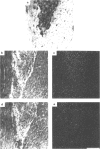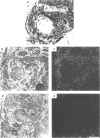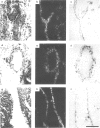Abstract
1. Potential mechanisms responsible for the prominent depression of atrioventricular conduction by adenosine have been investigated in guinea-pig heart. 2. Adenosine A1 receptors and nucleoside transport (NT) sites were identified and enumerated in cardiac myocytes, atrioventricular conduction cells and coronary endothelial cells in 10 microns sections by autoradiographical analysis of the binding of the A1 selective antagonist 8-cyclopentyl-1,3-[3H]-dipropylxanthine ([3H]-DPCPX) and the NT ligand [3H]-nitrobenzylthioinosine ([3H]-NBMPR), respectively. 3. Atrioventricular conduction cells were identified by acetylcholinesterase histochemistry and endothelial cells by von Willebrand factor immunohistochemistry. 4. Site-specific binding of [3H]-DPCPX, when expressed as grains per cell nucleus was significantly higher (30 fold) in conduction cells than in surrounding myocytes. [3H]-DPCPX site density on endothelial cells in adjacent coronary vessels was not significantly different from myocytes. 5. In contrast, autoradiography of [3H]-NBMPR sites in these areas indicated that, relative to myocytes, conduction cells and endothelial cells were significantly enriched (2 fold and 4.5 fold, respectively) in NT sites. 6. The pronounced dromotropic effect of adenosine in guinea-pig heart is correlated with a higher density of adenosine A1 receptors in atrioventricular conduction cells than in myocytes. The NT capacity of these cells, as estimated by [3H]-NBMPR binding site density, is not increased in proportion to A1 receptors.
Full text
PDF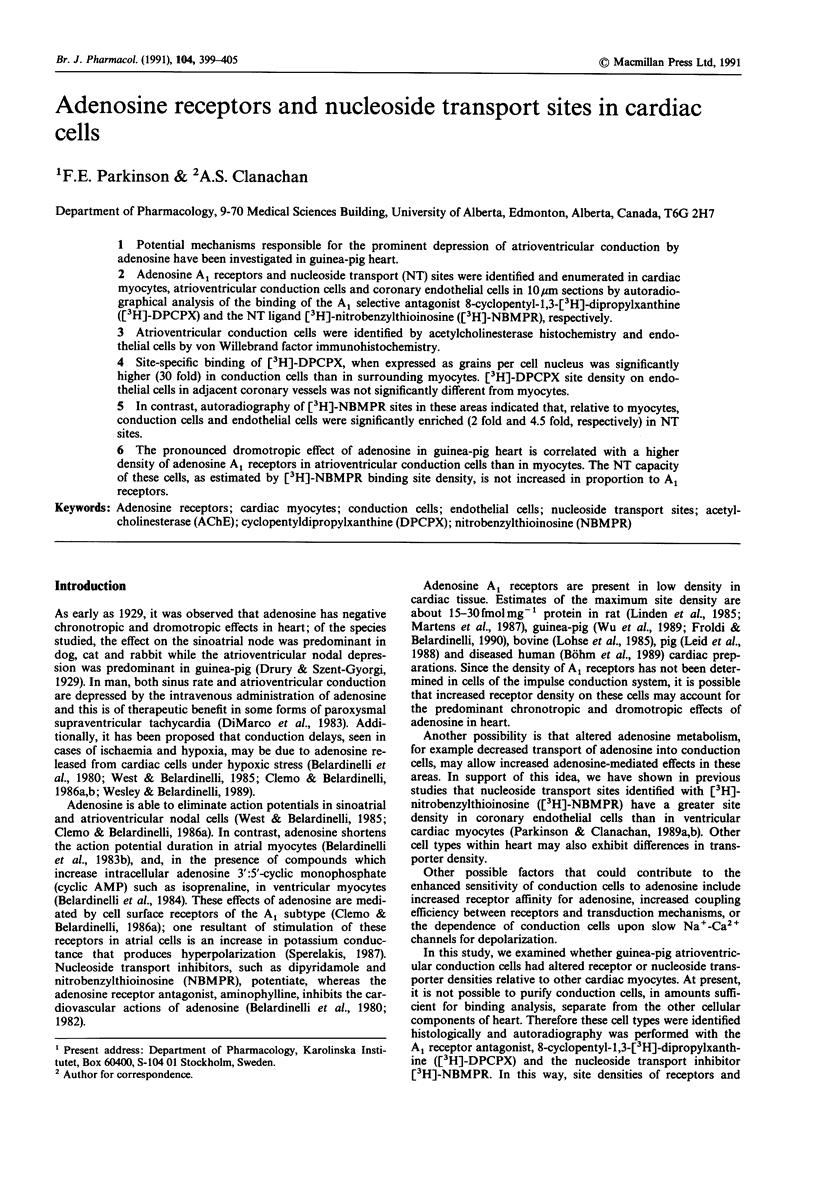

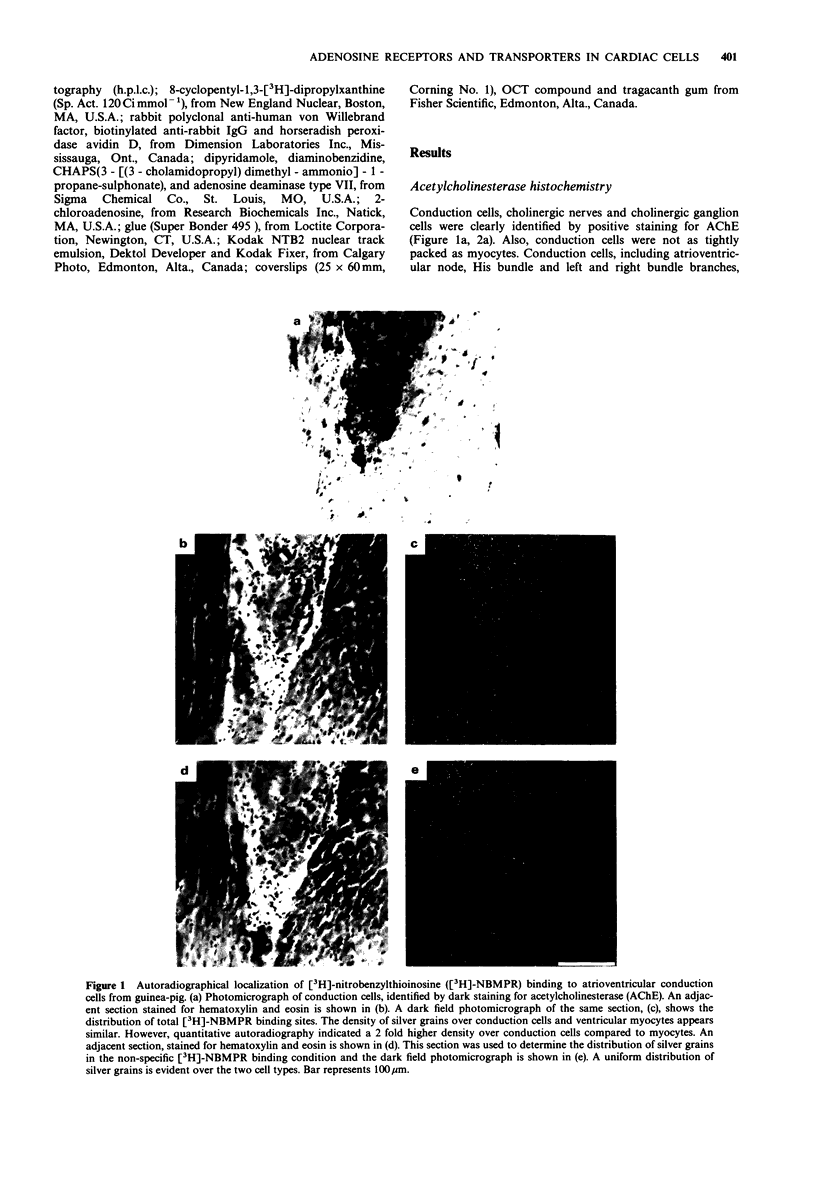
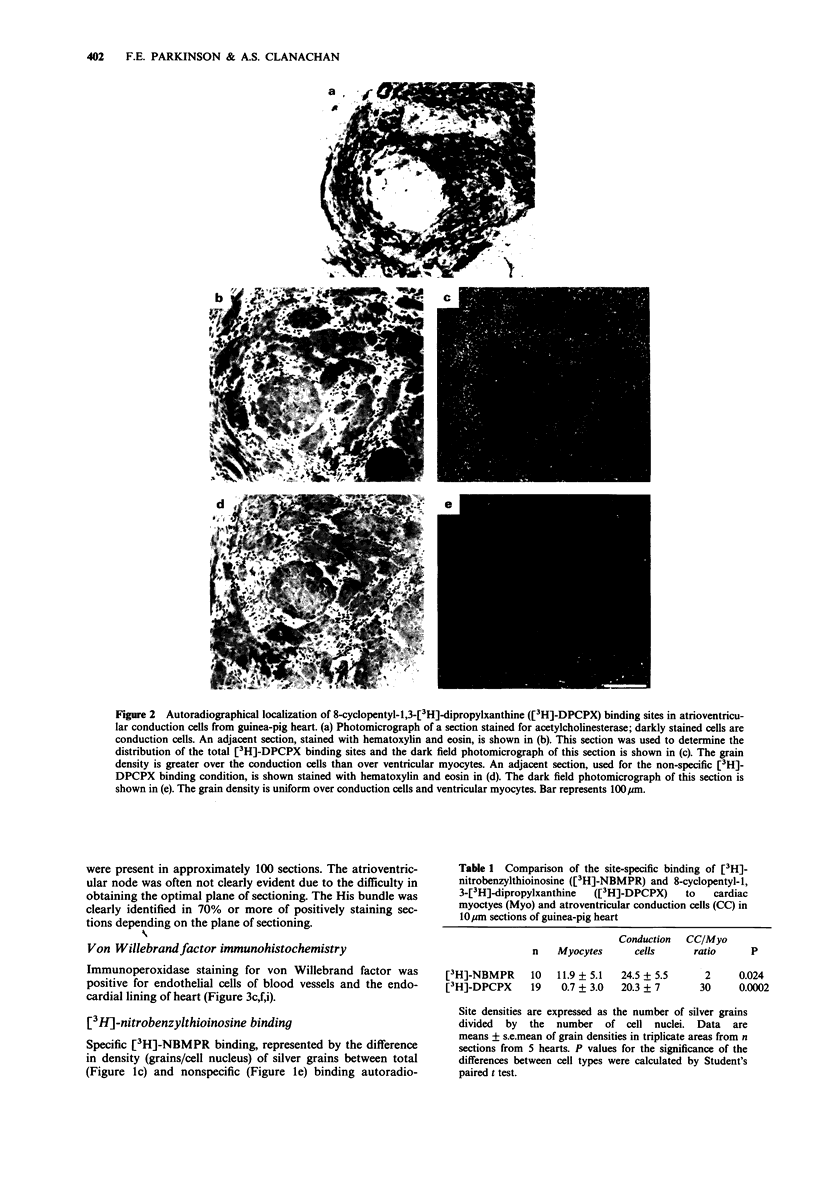
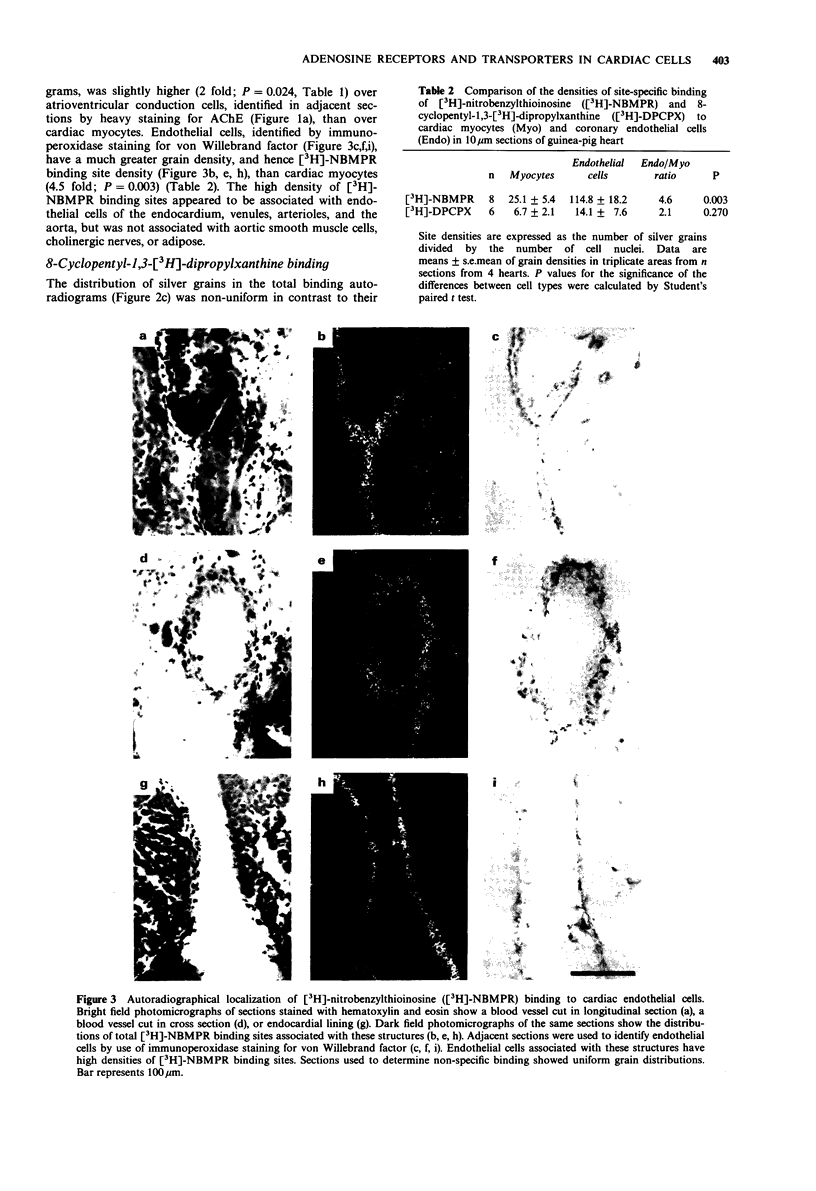
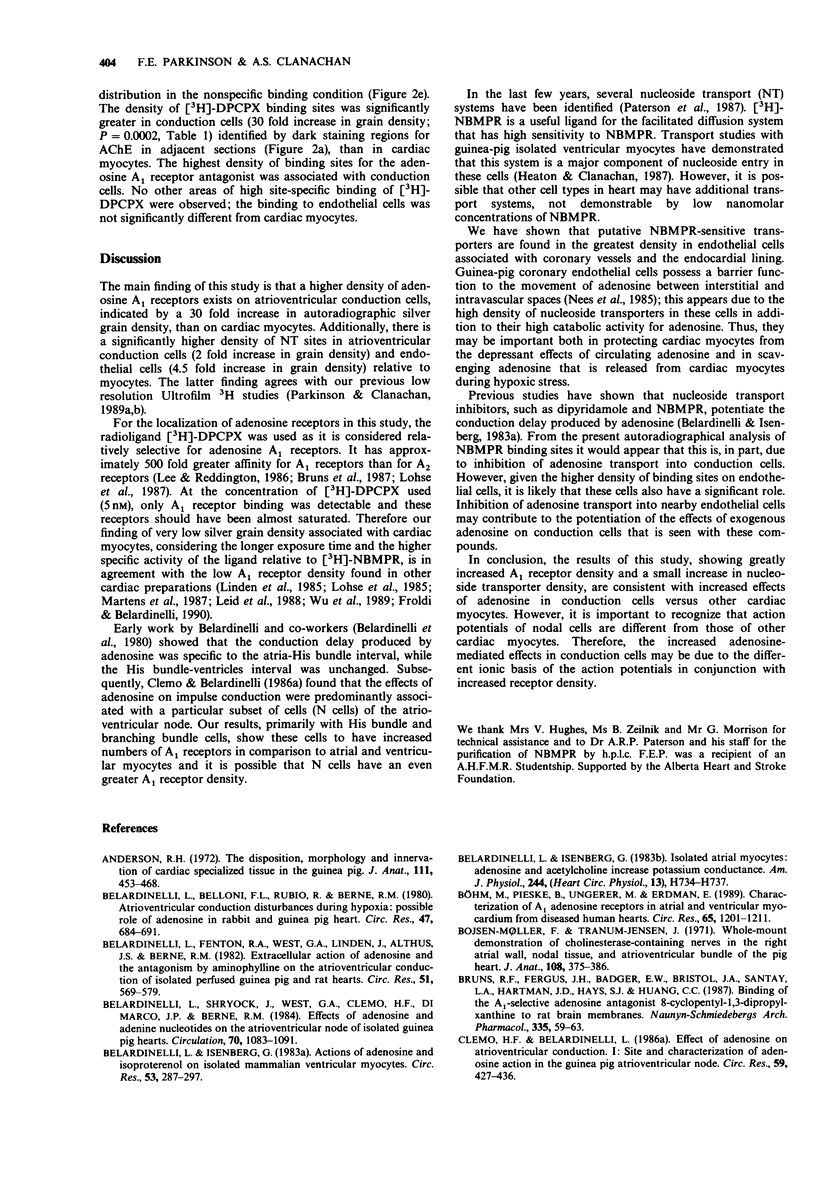
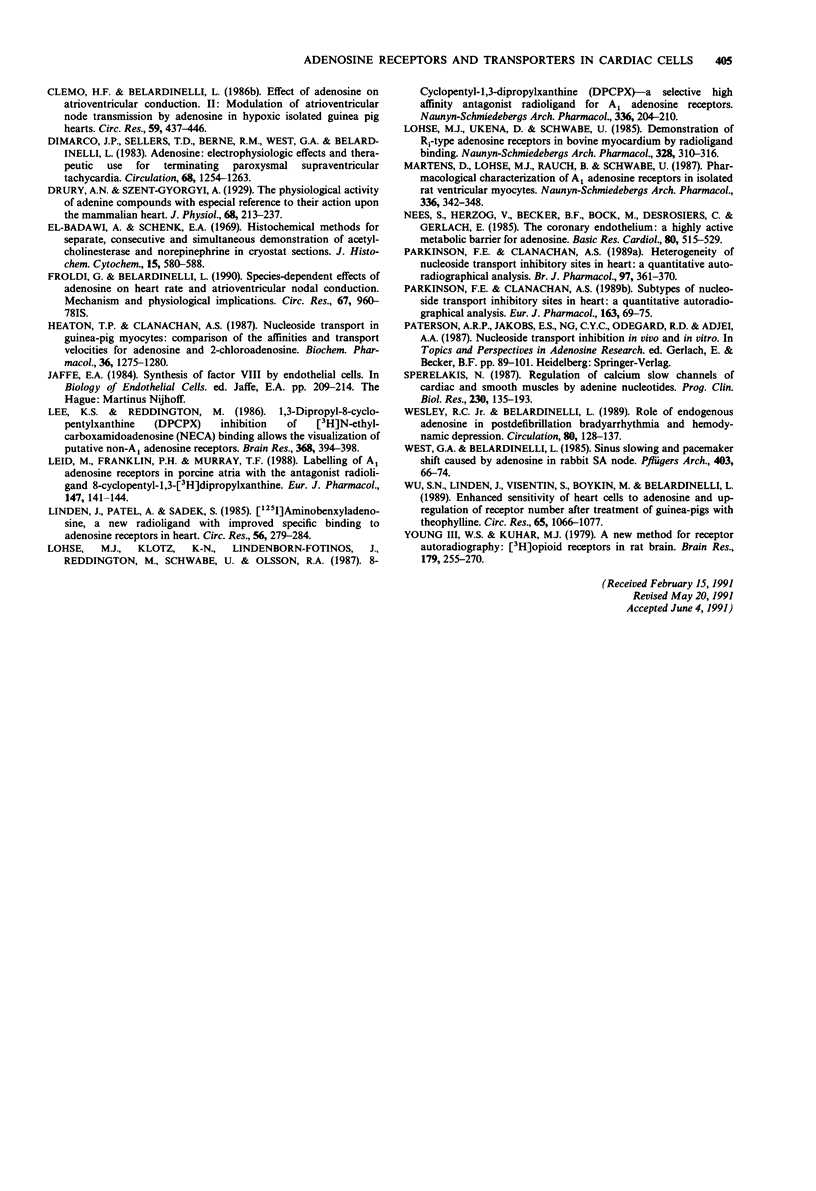
Images in this article
Selected References
These references are in PubMed. This may not be the complete list of references from this article.
- Anderson R. H. The disposition, morphology and innervation of cardiac specialized tissue in the guinea-pig. J Anat. 1972 Apr;111(Pt 3):453–468. [PMC free article] [PubMed] [Google Scholar]
- Belardinelli L., Belloni F. L., Rubio R., Berne R. M. Atrioventricular conduction disturbances during hypoxia. Possible role of adenosine in rabbit and guinea pig heart. Circ Res. 1980 Nov;47(5):684–691. doi: 10.1161/01.res.47.5.684. [DOI] [PubMed] [Google Scholar]
- Belardinelli L., Fenton R. A., West A., Linden J., Althaus J. S., Berne R. M. Extracellular action of adenosine and the antagonism by aminophylline on the atrioventricular conduction of isolated perfused guinea pig and rat hearts. Circ Res. 1982 Nov;51(5):569–579. doi: 10.1161/01.res.51.5.569. [DOI] [PubMed] [Google Scholar]
- Belardinelli L., Isenberg G. Actions of adenosine and isoproterenol on isolated mammalian ventricular myocytes. Circ Res. 1983 Sep;53(3):287–297. doi: 10.1161/01.res.53.3.287. [DOI] [PubMed] [Google Scholar]
- Belardinelli L., Isenberg G. Isolated atrial myocytes: adenosine and acetylcholine increase potassium conductance. Am J Physiol. 1983 May;244(5):H734–H737. doi: 10.1152/ajpheart.1983.244.5.H734. [DOI] [PubMed] [Google Scholar]
- Belardinelli L., Shryock J., West G. A., Clemo H. F., DiMarco J. P., Berne R. M. Effects of adenosine and adenine nucleotides on the atrioventricular node of isolated guinea pig hearts. Circulation. 1984 Dec;70(6):1083–1091. doi: 10.1161/01.cir.70.6.1083. [DOI] [PubMed] [Google Scholar]
- Bojsen-Moller F., Tranum-Jensen J. Whole-mount demonstration of cholinesterase-containing nerves in the right atrial wall, nodal tissue, and atrioventricular bundle of the pig heart. J Anat. 1971 Apr;108(Pt 3):375–386. [PMC free article] [PubMed] [Google Scholar]
- Bruns R. F., Fergus J. H., Badger E. W., Bristol J. A., Santay L. A., Hartman J. D., Hays S. J., Huang C. C. Binding of the A1-selective adenosine antagonist 8-cyclopentyl-1,3-dipropylxanthine to rat brain membranes. Naunyn Schmiedebergs Arch Pharmacol. 1987 Jan;335(1):59–63. doi: 10.1007/BF00165037. [DOI] [PubMed] [Google Scholar]
- Böhm M., Pieske B., Ungerer M., Erdmann E. Characterization of A1 adenosine receptors in atrial and ventricular myocardium from diseased human hearts. Circ Res. 1989 Nov;65(5):1201–1211. doi: 10.1161/01.res.65.5.1201. [DOI] [PubMed] [Google Scholar]
- Clemo H. F., Belardinelli L. Effect of adenosine on atrioventricular conduction. I: Site and characterization of adenosine action in the guinea pig atrioventricular node. Circ Res. 1986 Oct;59(4):427–436. doi: 10.1161/01.res.59.4.427. [DOI] [PubMed] [Google Scholar]
- Clemo H. F., Belardinelli L. Effect of adenosine on atrioventricular conduction. II: Modulation of atrioventricular node transmission by adenosine in hypoxic isolated guinea pig hearts. Circ Res. 1986 Oct;59(4):437–446. doi: 10.1161/01.res.59.4.437. [DOI] [PubMed] [Google Scholar]
- DiMarco J. P., Sellers T. D., Berne R. M., West G. A., Belardinelli L. Adenosine: electrophysiologic effects and therapeutic use for terminating paroxysmal supraventricular tachycardia. Circulation. 1983 Dec;68(6):1254–1263. doi: 10.1161/01.cir.68.6.1254. [DOI] [PubMed] [Google Scholar]
- Drury A. N., Szent-Györgyi A. The physiological activity of adenine compounds with especial reference to their action upon the mammalian heart. J Physiol. 1929 Nov 25;68(3):213–237. doi: 10.1113/jphysiol.1929.sp002608. [DOI] [PMC free article] [PubMed] [Google Scholar]
- El-Badawi A., Schenk E. A. Histochemical methods for separate, consecutive and simultaneous demonstration of acetylcholinesterase and norepinephrine in cryostat sections. J Histochem Cytochem. 1967 Oct;15(10):580–588. doi: 10.1177/15.10.580. [DOI] [PubMed] [Google Scholar]
- Froldi G., Belardinelli L. Species-dependent effects of adenosine on heart rate and atrioventricular nodal conduction. Mechanism and physiological implications. Circ Res. 1990 Oct;67(4):960–978. doi: 10.1161/01.res.67.4.960. [DOI] [PubMed] [Google Scholar]
- Heaton T. P., Clanachan A. S. Nucleoside transport in guinea pig myocytes. Comparison of the affinities and transport velocities for adenosine and 2-chloroadenosine. Biochem Pharmacol. 1987 Apr 15;36(8):1275–1280. doi: 10.1016/0006-2952(87)90081-5. [DOI] [PubMed] [Google Scholar]
- Lee K. S., Reddington M. 1,3-Dipropyl-8-cyclopentylxanthine (DPCPX) inhibition of [3H]N-ethylcarboxamidoadenosine (NECA) binding allows the visualization of putative non-A1 adenosine receptors. Brain Res. 1986 Mar 19;368(2):394–398. doi: 10.1016/0006-8993(86)90589-5. [DOI] [PubMed] [Google Scholar]
- Leid M., Franklin P. H., Murray T. F. Labeling of A1 adenosine receptors in porcine atria with the antagonist radioligand 8-cyclopentyl-1,3-[3H]dipropylxanthine. Eur J Pharmacol. 1988 Feb 16;147(1):141–144. doi: 10.1016/0014-2999(88)90644-9. [DOI] [PubMed] [Google Scholar]
- Linden J., Patel A., Sadek S. [125I]Aminobenzyladenosine, a new radioligand with improved specific binding to adenosine receptors in heart. Circ Res. 1985 Feb;56(2):279–284. doi: 10.1161/01.res.56.2.279. [DOI] [PubMed] [Google Scholar]
- Lohse M. J., Klotz K. N., Lindenborn-Fotinos J., Reddington M., Schwabe U., Olsson R. A. 8-Cyclopentyl-1,3-dipropylxanthine (DPCPX)--a selective high affinity antagonist radioligand for A1 adenosine receptors. Naunyn Schmiedebergs Arch Pharmacol. 1987 Aug;336(2):204–210. doi: 10.1007/BF00165806. [DOI] [PubMed] [Google Scholar]
- Lohse M. J., Ukena D., Schwabe U. Demonstration of Ri-type adenosine receptors in bovine myocardium by radioligand binding. Naunyn Schmiedebergs Arch Pharmacol. 1985 Jan;328(3):310–316. doi: 10.1007/BF00515559. [DOI] [PubMed] [Google Scholar]
- Martens D., Lohse M. J., Rauch B., Schwabe U. Pharmacological characterization of A1 adenosine receptors in isolated rat ventricular myocytes. Naunyn Schmiedebergs Arch Pharmacol. 1987 Sep;336(3):342–348. doi: 10.1007/BF00172688. [DOI] [PubMed] [Google Scholar]
- Nees S., Herzog V., Becker B. F., Böck M., Des Rosiers Ch, Gerlach E. The coronary endothelium: a highly active metabolic barrier for adenosine. Basic Res Cardiol. 1985 Sep-Oct;80(5):515–529. doi: 10.1007/BF01907915. [DOI] [PubMed] [Google Scholar]
- Parkinson F. E., Clanachan A. S. Heterogeneity of nucleoside transport inhibitory sites in heart: a quantitative autoradiographical analysis. Br J Pharmacol. 1989 Jun;97(2):361–370. doi: 10.1111/j.1476-5381.1989.tb11962.x. [DOI] [PMC free article] [PubMed] [Google Scholar]
- Parkinson F. E., Clanachan A. S. Subtypes of nucleoside transport inhibitory sites in heart: a quantitative autoradiographical analysis. Eur J Pharmacol. 1989 Apr 12;163(1):69–75. doi: 10.1016/0014-2999(89)90396-8. [DOI] [PubMed] [Google Scholar]
- Sperelakis N. Regulation of calcium slow channels of cardiac and smooth muscles by adenine nucleotides. Prog Clin Biol Res. 1987;230:135–193. [PubMed] [Google Scholar]
- Wesley R. C., Jr, Belardinelli L. Role of endogenous adenosine in postdefibrillation bradyarrhythmia and hemodynamic depression. Circulation. 1989 Jul;80(1):128–137. doi: 10.1161/01.cir.80.1.128. [DOI] [PubMed] [Google Scholar]
- West G. A., Belardinelli L. Sinus slowing and pacemaker shift caused by adenosine in rabbit SA node. Pflugers Arch. 1985 Jan;403(1):66–74. doi: 10.1007/BF00583284. [DOI] [PubMed] [Google Scholar]
- Wu S. N., Linden J., Visentin S., Boykin M., Belardinelli L. Enhanced sensitivity of heart cells to adenosine and up-regulation of receptor number after treatment of guinea pigs with theophylline. Circ Res. 1989 Oct;65(4):1066–1077. doi: 10.1161/01.res.65.4.1066. [DOI] [PubMed] [Google Scholar]
- Young W. S., 3rd, Kuhar M. J. A new method for receptor autoradiography: [3H]opioid receptors in rat brain. Brain Res. 1979 Dec 28;179(2):255–270. doi: 10.1016/0006-8993(79)90442-6. [DOI] [PubMed] [Google Scholar]



